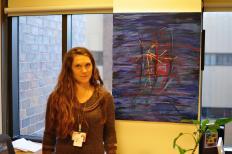







“But it’s all one brain,” she said with a laugh, “and it all somehow fits in [at] the same time.”
Her artwork is now on display among over 100 art pieces, representing 42 artists, on the third floor in the Ebling Library in the UW Hospital
Following an opening reception on September 27, the exhibition, titled “In Our Spare Time,” will last until the end of December.
The exhibits feature a wide range of mediums, including photos, paintings, quilts, and sculptures. They all come from staff at the health sciences schools and affilitated institutions. Here, you can see black and white photos from a psychiatrist, colorful paintings from a cardiologist, printmaking by emeritus veterinary faculty, and collages by counselors.
The show occupies two galleries and some space in the historical reading room. Most of the pieces are arranged either by color – several pieces containing pink are put together – or by themes, like landscape, flowers, and portraits.
Eckhardt submitted three oil paintings to the show.
Most of Eckhardt's paintings are inspired by a life event or natural phenomenon. One of her works on display, "Red Stripe," was inspired by a light across a rock face.
Eckhardt defined her genre as “abstract impressionism.” Unlike photographers who can recreate a realistic picture with cameras, she chooses painting to bring about a new interpretation of real life, a celebration, and an exaggeration of emotion, “like theater,” she said.
“Most people underestimate the creative energy of scientists,” said Eckhardt.
This art show enables her to show a different aspect of her life to colleagues. “The creative energy that I have for art is also what I try to bring to my patients, and to the procedures that I do, and research that I do.”
Indeed, through the art show, employees get to know each other better.

With little spare time, Zielinski said she really needed something to spur herself on, like the deadline for the art show. She went to art museums to get inspired as well.
Her work, a light box piece named "Self Portrait," is one the most popular works here. She combined an X-ray picture of herself with a painting of a heart and used a light box to illuminate the image.
The art show also features a few non-medical staff in the hospital, including Michael J. Killips, the manager of classroom & audio visual services in the Health Sciences Learning Center.
As a former communication art student and a video studio employee, he loves photography because it allows him to do some creative work.
“It’s a nice distraction,” he said, “it’s a different way to look at the world.”
Micaela Sullivan-Fowler, a librarian and curator at the Ebling Library, organized the show.
Though she started advertising about the coming art exhibition for faculty and staff as early as December 2011, these doctors, nurses, and staff didn’t submit anything until the last minute.
“I never saw one piece of art until the week before the deadline,” said Fowler. But the works of art, wrapped in bed sheets or shower curtains, finally found their way to the library.
Fowler was soon faced with another big challenge – she had to make sure that each piece, no matter how small or amateur it was, had its own impact. Working together with Sarah Grimes, Art Coordinator at the UW Hospital, she managed to put every piece in the right place, just before the opening reception.
It is significant to have such an event in a hospital, said Sullivan-Fowler. Art is a stress reliever that helps these busy medical practitioners escape from reality temporarily, she said.
“Your brain goes ... elsewhere when you’re creating art.”
|
|
|
Welcome to the Madison Commons, a website designed to provide news and information about all of Madison's neighborhoods and a crossroads for the discussion of community issues. The name comes from the idea of a village commons, a place for news, talk, debate, and some entertainment, too, that's open to everyone.
All rights reserved. Read more about the Madison Commons and its partners.

